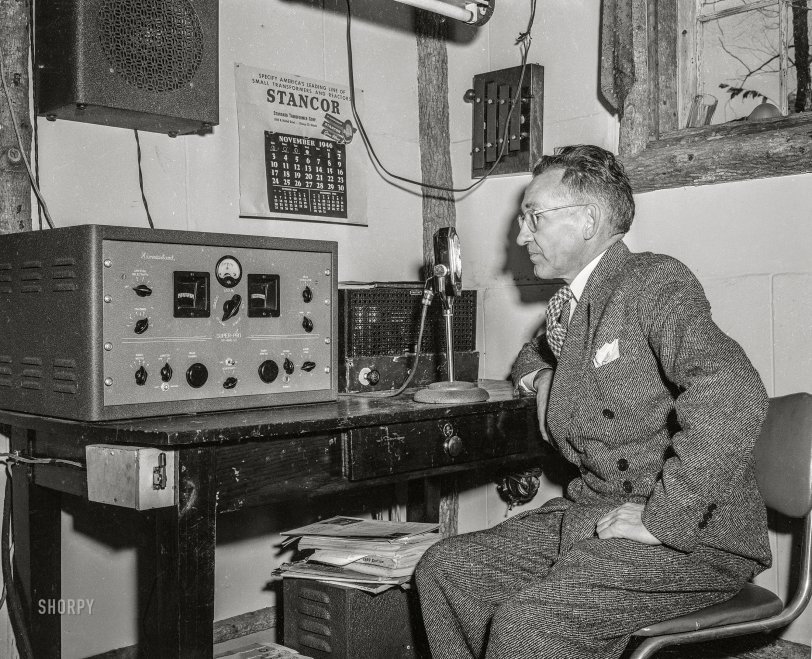


Framed or unframed, desk size to sofa size, printed by us in Arizona and Alabama since 2007. Explore now.
Shorpy is funded by you. Patreon contributors get an ad-free experience.
Learn more.

- Baldwin 62303
- Baldwin VO-1000
- Cold
- No expense spared
- Tough Guys
- Lost in Toyland
- And without gloves
- If I were a blindfolded time traveler
- Smoke Consumer Also Cooks
- Oh that stove!
- Possibly still there?
- What?!?
- $100 Reward
- Freeze Frame
- Texas Flyer wanted
- Just a Year Too Soon
- WWII -- Replacing men with women at the railroad crossing.
- Yes, Icing
- You kids drive me nuts!
- NOT An Easy Job
- I wonder
- Just add window boxes
- Icing Platform?
- Indiana Harbor Belt abides
- Freezing haze
- Corrections (for those who care)
- C&NW at Nelson
- Fallen Flags
- A dangerous job made worse
- Water Stop
Print Emporium
Hamateur: 1946

From November 1946 comes this sighting of the rare Double-Breasted Ham, now believed to be extinct, in its natural woodsy habitat. The male's distinctive call could be heard for miles. 4x5 inch acetate negative fron the Shorpy News Photo Archive. View full size.
Must Be Casual Friday
I'm assuming his shoes are shined.
What goes around comes around
The eyeglass frame he is wearing has come back in style since about 2000.
Backup tie
Our gent appears to have a backup tie handy, presumably dangling from the curtain rod (perhaps a branch, just to stay with the outdoor theme). It's also hard not to notice that the lamp wiring isn't exactly up to code. Roughing it!

Profiles in Radio
Truthfully, I think he looks like Harry S. Truman.
The Mike
is a Universal Velocity Microphone model M4 from the 1930s.
Just in case someone asks
What are you wearing?
Itchy & Scratchy
That suit says nothing but "suffer."
J.C. Deagan Chimes
I have a five-note set of those Deagan chimes seen on the wall just above the ham's noggin. Mine were used in a railroad dining car to announce dinner. The NBC bing, boing, bong (I think that's right?) was presumably the notes G, E, C for the owner at the time, General Electric Company.
That xylophone
for his call letters? Like the "G, E, C" tones for NBC?
Those chimes!
I'm loving the chimes on the wall above the operator. Can anybody comment on why they are there? Did ham radio operators have their individual call chimes as well as call signs?
I saw the chimes and immediately heard the NBC sounds - G, E, C.
NBC-inspired?
I see the chimes on his wall. I wonder if he had his own signature three-tone sign-on or sign-off like NBC back in the day.
Wood trim with bark
I wonder if this was his man-shed with the woodsy trim. Also somewhat unbelievably, the Stancor transformer company is still around.
Hammarlund, Radio at its Best!
This gentleman appears to be operating a Hummarlund Super Pro, which debuted in 1936. They finally gave up the ghost in 1973, winning the distinction as the oldest radio equipment company. However, Stancor (manufacturers of transformers and that fancy calendar) is still around today.
He looks like Giancarlo Esposito
High End Hammarlund receiver
So many things to note in this photo. 1937 call book (sort of a phonebook for Hams), the open splice on the overhead lamp cord, back issues of QST magazine -- still an ARRL publication today.
The Hammarlund Receiver Super-Pro is still sought after today. What's not seen in the picture is the operator's transmitter. I suspect it is a Pre-War "homebrew" rack mount to the left and out of frame. The equipment to the right of the receiver looks to be a speech amplifier or "modulator" -- a common modification to enable the use of "AM Phone" with a older "CW" (code) transmitter. The Stancor calendar is indication this Ham built his own equipment, as was common.
-- Steve W1TAV
Scratchy prone
Not just the reception - or his suit - but the equipment itself: the set, the microphone base, whatever-it-is at his feet -- all seem to be coated in that faux hammered-finish paint (once very popular, for some reason, on electrical equipment) that inevitably got scratched, and was then nearly impossible to touch-up cleanly. And it usually got scratched when you tried to loosen some factory (over)tightened fastener, and the screwdriver would slip and go wild -- a subtle way to discourage DIY repairs, perhaps.

























On Shorpy:
Today’s Top 5